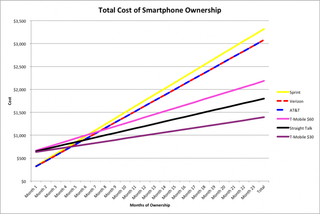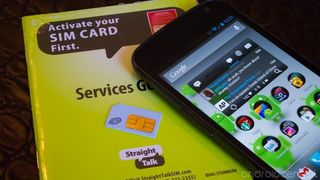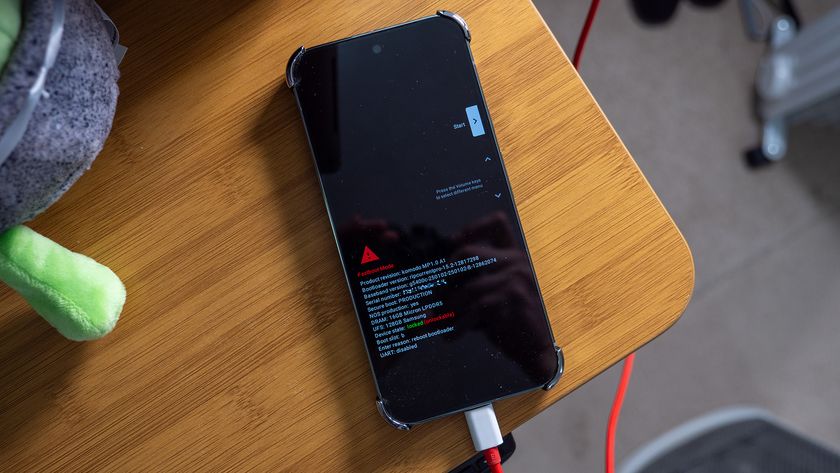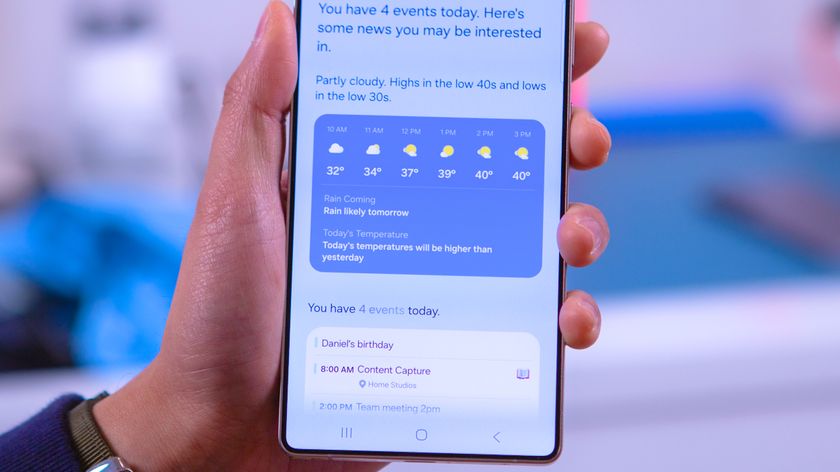Prepaid: Not just for burner phones anymore

My phone works just like yours. It makes calls, sends texts and has a high-speed data connection with nationwide coverage. As a matter of fact, I have the same device as many of you, a Samsung Galaxy Nexus. That’s all run-of-the-mill, so why’s this important? I pay $45 every month to use my phone.
“That’s crazy,” you might be saying, “I pay more for my data plan than you pay for your entire phone bill”. You’re right, it is kind of crazy. The cost of cellphone service in the United States is quite astronomical when compared to services around the world. The common misconception, however, is that there are no other options if you want to pay less for your service.
The true cost of cell phone ownership

Here in the United States, carrier advertising has a disproportionate amount of emphasis put on the up-front cost of the device, rather than the monthly service cost or total cost over the course of a 2-year contract. They want to entice you with a “cheap” device at $99, or a high-end device for as much as $299. What a deal, right? What they tend to hide, so to speak, is the monthly cost of ownership. For an individual, a contract from Verizon, Sprint or AT&T will set you back upwards of $100 per month. At the end of your two-year commitment, the $99 or $299 you spent on your device pales in comparison to the $2500 you just spent for service.
So let’s look at a quick example of buying a Samsung Galaxy SIII (S3) on the big, popular networks with a 2-year contract for each carrier’s unlimited plan (2GB and 3GB data plans selected on Verizon and AT&T, respectively, as they don't have unlimited options at this time), and compare it to three popular prepaid carriers. On the big 3, you’re paying $199 up front and signing a contract for service in the $120 per month range. On the 3 popular prepaid carriers I’ve selected, you’re looking at $599 (usually less nowadays, but we’ll keep it simple) for the device and $30, $45 or $60 per month (calculations here include a sales tax of 10%, which is about as high as you'll see) for service. Let’s see how the numbers come out after 2 years of phone ownership:


The numbers don't lie. With the same phone and relatively the same service (or even better in terms of data offerings) from a prepaid carrier, you'll save hundreds -- or even thousands -- of dollars over the life of the 2-year contract. The deceptive marketing of the major carriers in the U.S. masks the true cost of ownership of a device over the life of the contract. Putting it on a chart like this, which shows that even in the most expensive case you "break even" in 8 out of 24 months, makes it extremely clear what savings there are to be had by going prepaid.
Now there’s no need to keep making the same point over and over, I think the above chart and graph speak for themselves. There’s no way to make a blanket statement about everyone’s situation, but the numbers would have to be significantly different for the prepaid carrier to ever be more expensive than the postpaid carrier in the long term -- or even the relatively short term.
Prepaid plan selection
There are officially some 40 distinct MVNO (Mobile Virtual Network Operators) carriers in the U.S., giving you plenty of options to choose from. For the sake of convenience, there are really only two providers that are worth looking at right now.
Be an expert in 5 minutes
Get the latest news from Android Central, your trusted companion in the world of Android
One of the numerous MVNOs running under the TracFone parent company, Straight Talk offers a fantastic value with their single plan. Unlimited Minutes, Unlimited Texts, and Unlimited Data, all for $45 (+ applicable sales taxes). Straight Talk offers service on either AT&T or T-Mobile depending on what your phone is compatible with, and is a great option for those who need the better coverage area nationwide offered by AT&T’s towers. While the plan says "unlimited", their terms of service indicate that they have the discretion to throttle your speeds for whatever they deem excessive use. It really depends on your market (how many other Straight Talk users are around you), but I've not had any issues keeping my speeds and using plenty of data.
T-Mobile offers a few different tiers of its prepaid service, dubbed Monthly 4G. The first tier is just $30 per month, and offers 100 Minutes, Unlimited Texts, and 5GB of 4G data. The second is $50 per month, and offers Unlimited Minutes, Unlimited Texts, and 100MB of 4G data. The third, $60 for the same but 2GB of 4G data. The last is $70, with 5GB of 4G data. Seems like a lot of options, but it’s good that T-Mobile offers different tiers to save people some money. The most compelling option for many will be the $30 plan because talk minutes are starting to become less and less important.
Honorable mentions

Device selection
At this point we’ve established that switching to a prepaid service and buying your device at full price can save a substantial amount of money. But what device do you choose? Where do you find devices for prepaid service? For many people reading this article, the idea of going online to a smartphone importer and buying an unlocked device doesn’t sound too scary. To others, they may prefer the ease of walking into a store and buying a device in person. Both people have options, but unfortunately given the current state of the U.S. market, those willing to buy online may have a better selection.
For the latest high end devices, you have several options. Because of manufacturer agreements with carriers, they very rarely will sell directly to consumers. Luckily, there’s quite the market for unlocked devices online. From popular retailers like Amazon and Newegg to your smaller outfits around the internet, you’ll have plenty of options if you’re okay with buying online. Prices vary quite widely on unlocked devices, especially if you’re trying to get in on the first day of a device launch, but there are definitely deals to be had. Unlike buying directly from carriers, unsubsidized prices can come down over time.
For those who want to buy a device in store, you’re not out of luck! It may not always be the most cost effective option, but carriers and retailers like Best Buy and Radioshack will sell handsets at full price, and sometimes unlocked. The prices will often be high in order to entice people into contracts, but we understand if the security of buying at a store is worth a few extra dollars. If the phone is SIM locked, you’re not always out of luck. For example, phones SIM locked to AT&T can often be used on AT&T MVNO carriers without issues. If you want it unlocked, several services around the internet offer unlock codes for a nominal fee.
One word of warning when buying your device is to make sure you’re buying the proper model. Check ahead of time that the device has the correct radio bands for your carrier of choice, and that it comes SIM unlocked (if possible). A full manufacturer’s warranty is not a guarantee with these devices, as they’re often imported from other countries, so make sure to read the fine print. Luckily, third party phone insurance companies often cover unlocked phones the same way they would a carrier device.

Paying your bill
Filling up your prepaid phone account doesn’t require buying a card at a gas station and scratching a code off the back with a coin anymore. Any MVNO worth it’s salt today offers auto-refill options that automatically deduct from your credit or check card, meaning you never have to think about whether your phone will shut off on you at the end of the month. Once you get in the cycle of using your device and auto-refilling the service, it’ll feel the exact same as a postpaid contract plan. Keep the funds there, and your phone keeps working.
Things to know (odds and ends)
While I’ve chosen to put more emphasis on buying unlocked devices and using GSM carriers, the more “traditional” prepaid model of buying a cheap phone from the prepaid carrier and keeping the monthly costs as low as possible is the most viable option for some. Prepaid carriers like Virgin Mobile, Boost Mobile and Cricket Wireless offer everything from the cheapest flip phone up to mid-range devices like the HTC Evo 3D and now even higher end devices like the Samsung Galaxy SII (S2) and iPhone 4/4S as of late. They pair these phones with extremely cheap plans -- around $30 to $50 per month. You can’t unlock and take the phones to other carriers, but for the extremely budget conscious among us, there are great values to be had with these carriers.
The reasons I moved from traditional postpaid phone service to prepaid were twofold. First, I just like saving money -- and who doesn't, right? Second, and most importantly, I was tired of dealing with carriers. I was tired of waiting for updates, not having good device selection, uninstallable bloatware, carrier locked firmware, plan restrictions, everything. I was just tired of it all. I just wanted to buy the device I want and use it how I want, without any carrier telling me I couldn't. Everyone out there, from the hardcore phone enthusiast to the average user, has a bad story about how they were treated by their carrier or how they're not getting what they paid for.
I'll be the first to say that moving to a prepaid phone service isn't for everyone. But if you're at all like me, prepaid is just what the doctor ordered.
Andrew was an Executive Editor, U.S. at Android Central between 2012 and 2020.













